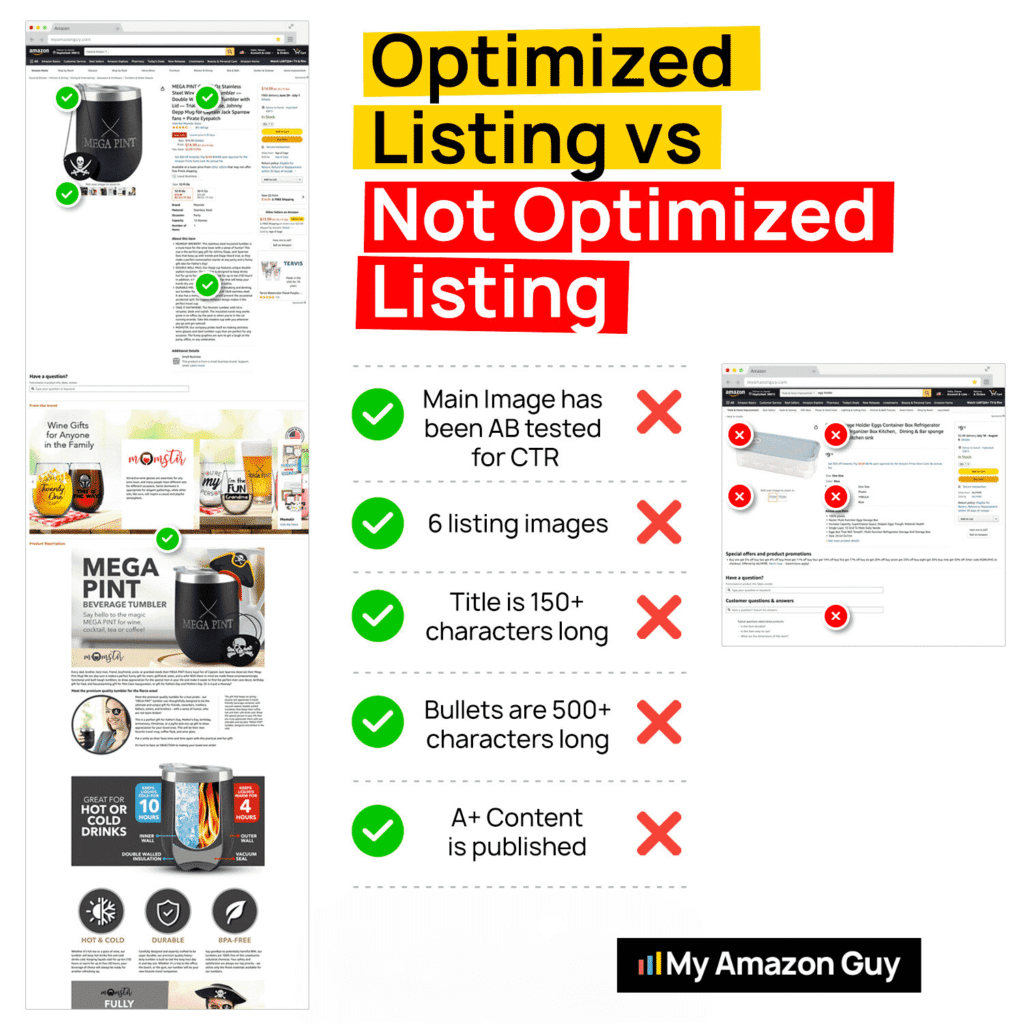Last Updated: July 25, 2025
Want to know how to take your Amazon product listing from zero to hero in reviews and rankings? These 2025 Amazon product launch strategies might be your best bet.
You poured your heart (and wallet) into creating an amazing product, you listed it on Amazon, hit “publish”, and… nothing. Your product gets lost in the Amazon abyss, collecting dust or, worse, filled with negative reviews.
See, without visibility, even great products never get a fair shot. But there’s good news: you’re not stuck.
This guide covers every key Amazon product launch strategy, from market research and listing optimization to review generation and post-launch tracking. Use these proven tactics to gather feedback, drive sales, and rank high from day one.
Table of Contents
Need an Amazon Launch Game Plan?
Follow a launch strategy built for real results, not hype. Get personalized support and insights tailored to your brand.
15 Amazon Product Launch Strategies That Actually Work
When you launch a product on Amazon, even if it’s incredible, poor execution can leave it buried under millions of listings. So, use these Amazon product launch strategies to stand out, rank higher, and build momentum fast.
Amazon Product Launch Strategy 1: Thoroughly Research Your Products
Before launching a product on Amazon in 2025, conduct thorough research to ensure you’ve chosen a winner. Identify products with high demand and low competition by analyzing:
- Demand: Search volume, sales estimates, and market size
- Competition: Number of sellers, Amazon seller reviews, and product differentiation
- Profitability: Profit margin, product lifespan, and target market analysis
A. Target Market Analysis
Understand your ideal customer by delving into demographics, interests, and needs. Analyze:
- Demographics: Age, gender, location
- Interests: Hobbies, passions, online behaviors, lifestyle, and values
- Needs and Pain Points: Common problems, desired solutions, aspirations, and goals
B. Unique Selling Proposition
Develop a USP that sets your product apart from competitors. Consider:
- Identifying competitors’ strengths and weaknesses
- Analyzing customer needs and pain points
- Focusing on unique features and benefits
- Communicating your USP clearly and consistently across all marketing channels
Amazon Product Launch Strategy 2: Find the Best Keywords to Target
If you want your products to be findable on Amazon, you need to use the right keywords in your listing. That means identifying the exact search terms your target customers are typing in when they shop for products like yours.
A. Perform Keyword Analysis and Prioritization
Choose keywords based on how relevant they are, how often shoppers search for them, and how competitive they are. Focus on highly relevant keywords with moderate to high search volume and manageable competition.
B. Do Keyword Integration and Optimization
Integrate your chosen keywords throughout your product listing, including the title, description, bullet points, and A+ content. Make sure every keyword usage is natural and relevant to the product’s context.
C. Monitor and Refine Keywords
Regularly monitor your keyword performance using Amazon’s analytics tools. Adapt your keyword strategy based on insights, adding new relevant keywords and refining existing ones.
D. Use Amazon Keyword Research Tools
The best way to find keywords that actually drive traffic to your listing is by using keyword research tools like Amazon Brand Analytics and external tools like Jungle Scout. Use these tools to find the right search terms, check competitor rankings, and build a keyword strategy that makes sense for your product.
Amazon Product Launch Strategy 3: Create an Accurate Product Listing
Create an accurate product listing by selecting the right category and filling out all required fields. This ensures your product is searchable, indexed correctly, and shown to the right shoppers.
Include key details like your product title, description, images, price, brand, SKU, and fulfillment method. A complete and clear listing not only builds trust but also makes your ASIN eligible for FBA or merchant-fulfilled orders.
Amazon Product Launch Strategy 4: Set the Launch Dates
Setting a launch date helps avoid customer confusion, generate anticipation, organize inventory, and coordinate marketing efforts. Therefore, set strategic launch dates that align with your readiness and business goals.
Set the date for the following:
- Launch Date: The official debut of your product on Amazon.
- Release Date: The date customers can purchase your product.
- Offer Date: The start date for special offers or deals.
Amazon Product Launch Strategy 5: Do Not Run Out of Stock
Running out of stock is one of the worst mistakes you can make when launching a product on Amazon. Make sure your inventory is ready, whether you’re using FBA, FBM, or both.
Use Amazon’s shipping queue to create a plan if you’re using FBA, and follow packaging requirements to avoid delays. For FBM, prepare inventory in-house, ensure fast shipping processes, and track deliveries to avoid customer complaints.
Amazon Product Launch Strategy 6: Optimize the Product Listing
Listing optimization is non-negotiable if you want your product to get found and convert on Amazon. Here are proven ways to fully optimize your listing:
- Use high-quality, CTR-optimized main images and secondary images.
- Write a keyword-rich title, bullet points, and product description that clearly show your USP.
- Add a Brand Story to connect with your audience.
- Use A+ Content with crawlable text and image alt text to boost conversions.
- If eligible, upgrade to Premium A+ Content and include videos like unboxings or customer testimonials.
- Set up Complementary Product Sets to increase Average Order Value (AOV).
Struggling with Your Product Launch?
Avoid costly mistakes and guesswork. Let our experts guide your next product launch from planning to profit.
Amazon Product Launch Strategy 7: Set Up Your PPC Campaigns
Relying only on organic traffic during a product launch is a quick way to get buried by the competition. Use Amazon PPC campaigns to boost visibility, drive targeted traffic, and collect data that helps you scale faster.
Below are tips to set up PPC campaigns that support a successful product launch:
- Define clear PPC goals before launching any campaign.
- Choose the right ad format: Sponsored Products, Product Display Ads, or Video Ads.
- Conduct deep keyword research to target what your audience is actually searching for.
- Set competitive bids and optimize for placements that drive conversions.
- Monitor your campaigns regularly and make adjustments based on performance.
- Register your brand with Amazon Brand Registry to unlock advanced ad tools.
- Use Amazon Attribution to track PPC performance across multiple traffic sources.
- Start with a $100/day budget to collect performance data, then scale up as you go.
- Use and test multiple video ads with different hooks in the first 3 seconds.
- If PPC feels overwhelming, consider hiring a professional to manage your campaigns effectively.
Amazon Product Launch Strategy 8: Drive External Traffic to Your Listing
Amazon has a built-in audience ready to buy, but relying solely on it limits your reach. Driving external traffic gives your product added visibility, builds brand awareness, and fuels long-term growth.
Here are ways you can do this:
- Influencer Marketing: Partner with influencers in your niche to promote your product to their followers.
- Paid Advertising: Use platforms like Google Ads and Meta Ads to target potential buyers off Amazon.
- Email Marketing: Build an email list and send targeted campaigns promoting your product to subscribers.
- Social Media Campaigns: Run giveaways or promotions on platforms like Instagram and TikTok to create buzz.
- Content Marketing: Create blog posts, videos, and social media content that highlight your product’s value and link back to your listing.
Amazon Product Launch Strategy 9: Get Reviews on Amazon
Getting reviews early is key because most shoppers won’t buy a product without them. No reviews often signal risk to buyers, killing your conversion rate from the jump.
Use the Amazon Vine program to get 20–30 trusted reviews from Amazon-approved reviewers. If you’re launching multiple variations, enroll each one separately to maximize review count.
The goal is 30 reviews in 30 days to boost visibility and conversions. Positive reviews also build trust, improve product perception, and help shape your brand’s reputation.
Amazon Product Launch Strategy 10: Launch With a Competitive Price
When new products get launched on Amazon, shoppers are more likely to buy if the price looks like a great deal. But offering a discount for too long can kill your profit margin and hurt your perceived value.
So, follow this gradual price reduction strategy:
Week 1: 50% off – Ignite interest, generate buzz, and establish momentum.
Week 2: 40% off – Sustain interest, encourage more sales, and solidify your position.
Week 3: 35% off – Keep shoppers engaged, drive conversions, and build credibility.
Week 4: 30% off – Broaden appeal, accelerate sales, and strengthen market presence.
Week 5: 25% off – Maximize velocity, get reviews, and work toward best-seller status.
Week 6: 20% off – Maintain momentum and capture market share.
This structured price strategy encourages early adopters to take a chance on your product. It also helps fuel word-of-mouth, drive conversions, and attract more customers over time.
Amazon Product Launch Strategy 11: Monitor Inventory
Staying in stock during your launch is crucial if you want to maintain momentum and capture every sale. Inventory gaps can damage your rankings, delay growth, and frustrate customers who are ready to buy.
Monitor your inventory levels regularly and set restock alerts to avoid stockouts. The goal is to keep the product flowing without tying up too much capital in overstock.
Use Amazon’s Demand Forecasting Tool to predict product demand more accurately. Factor in sales trends, campaign activity, seasonality, and market behavior to make smarter replenishment decisions.
Read How to Use Amazon Demand Forecast Tool for Effective Inventory Management to learn more.
Amazon Product Launch Strategy 12: Run Discounts and Promotions
Running discounts and promotions during launch helps attract price-sensitive shoppers who are hesitant to try new products. It also jumpstarts your sales velocity, which is a key signal Amazon’s algorithm uses to improve your product ranking.
Use Lightning Deals to drive fast, time-sensitive traffic and create urgency around your launch. Pair that with coupons to make your offer stand out in search results and increase click-through rates.
Promotions like percentage-off or buy-one-get-one can encourage larger purchases and help generate early reviews. The combined effect improves your visibility, credibility, and long-term sales potential.
Amazon Product Launch Strategy 13: Measure Performance
Track your product’s performance using key Seller Central metrics like units sold, conversion rate, and sales velocity. This data helps you evaluate how well your launch strategy is working and how the market is responding.
Use customer reviews, surveys, and social media comments to identify issues or opportunities for improvement. Monitor keyword rankings closely; optimize top-performing keywords and adjust or replace the ones that aren’t driving traffic.
Amazon Product Launch Strategy 14: Engage Your Audience
Engaging your audience during a product launch helps build trust, boost conversions, and drive long-term brand loyalty. Start by responding quickly and professionally to customer inquiries, reviews, and feedback using Amazon’s communication tools.
To take it further, implement loyalty programs, referral incentives, and personalized outreach based on customer behavior. Stay active on social media, send targeted email campaigns, and always aim to deliver exceptional customer service that keeps buyers coming back.
Amazon Product Launch Strategy 15: Continuously Optimize
Part of running a successful Amazon business is to continuously optimize your product after launch so it stays competitive and appealing. This means refining your listings using customer feedback, updating images, enhancing A+ content, and adjusting pricing based on demand and market trends.
It also includes expanding your product line with variations or complementary items and preparing for major shopping events like Prime Day or Cyber Monday. Use these events to test promotions, apply seasonal updates, and closely monitor performance to make quick, effective changes.
Product Launch Mistakes That Can Tank Your Sales
Learning about the common mistakes that sellers make when launching a product is also one of the smartest strategies you can use because it helps you avoid disaster before it even begins. Here are five of the worst product launch mistakes you need to steer clear of:
- Launching Without Doing Market Research
Going into a saturated niche without understanding the demand or competition is one of the fastest ways to waste time and money. If you don’t validate your product with proper research, you’re just guessing, and guessing doesn’t pay the bills. - Poorly Optimized Product Listings
Bad titles, weak bullet points, low-quality images, and missing keywords kill conversions and visibility. Amazon rewards optimized listings, so if you skip this step, you’re leaving money on the table. - Mismanaging PPC Campaigns
Launching PPC without clear goals, targeting too many keywords, or relying heavily on broad match can quickly drain your budget. Worse, not negating non-converting search terms means you’re literally paying for clicks that won’t convert. - Ignoring Inventory Management
Running out of stock during a launch doesn’t just cost you sales, since it also resets your momentum and hurts your ranking. On the flip side, overstocking without a plan can crush your cash flow and rack up storage fees. - Focusing Too Much on Reviews Too Early
Reviews matter, but obsessing over them before you’ve driven real sales traffic will not do you any good. Let orders come in first, and the reviews will follow naturally (and more positively).
Frequently Asked Questions
How do I get initial sales for a new Amazon product?
Use PPC campaigns, offer time-limited discounts, and target similar products with competitor ads. This helps drive sales quickly and build momentum.
How can I rank high in search results during a launch?
Optimize your listing with strong keywords, generate steady initial sales, and get conversions on relevant search terms. These signals tell Amazon your product is worth showing.
Why is it important to gather feedback early on?
Early reviews help build customer trust and improve your product if needed. Honest feedback also helps fine-tune your listing and increase future conversions.
Don’t Let Launch Day Jitters Derail Your Success!
Your strategy for selling on Amazon should be well-planned, data-driven, and focused on delivering real value so that you can drive sales, rank high, and build customer trust. Every move, whether it’s optimizing your listing, promoting your launch, or gathering feedback, should support your product’s long-term growth.
By using the strategies mentioned in this guide, we hope you get the results you want when launching your products on Amazon. Stay consistent, keep learning, and always put your customer first to build a brand that lasts.
Struggling to launch your product successfully? Contact our full-service Amazon agency and let our team of experts help you out!
Tired of Low Sales After Launch?
Don’t let poor strategy kill your momentum. Get hands-on help to fix your launch and boost ranking fast.




